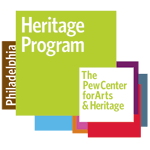Listen to a short description of this lost landscape, an elephant in Philadelphia, and then scroll down to see what used to be here on the site where you are now standing.
When this elephant came to Philadelphia in the winter of 1796-97, where did he stay?
The broadside (larger version) says the elephant was displayed in Philadelphia's "New Theatre," which in 1797 would have meant the new, fashionable Chestnut Street Theatre on the northwest corner of 6th and Chestnut Streets. But all the newspaper advertisements for the elephant's appearance in Philadelphia that winter state that the elephant was displayed somewhere across the street from where you are now, on the south side of Market Street between 3rd and 4th Streets. The author of this Massachusetts broadside might have just made up the part about the New Theatre to increase the elephant's cachet to his own customers.
It's hard to imagine where exactly the elephant stayed here on Market Street; there's no record of any theater, circus, or menagerie on this block in 1796-97. During his months here, the elephant's neighbors on Market would have included artisans, several merchants, a grocer, and a state official, and he would have been only a half-block from the residence of Pennsylvania's governor. The urbane character of this neighborhood can be seen in the image below of the southeast corner of 3rd and Market in 1800 shows 3rd Street running from the lower left (north) to the right (south) in the foreground, with Market running up the left side of the image. To see this vista now, walk to the corner of this alley and Market Street and look to the left and across the street to the southeast corner of 3rd and Market. (View this same scene in 1960 and 2000.)
It's hard to imagine where exactly the elephant stayed here on Market Street; there's no record of any theater, circus, or menagerie on this block in 1796-97. During his months here, the elephant's neighbors on Market would have included artisans, several merchants, a grocer, and a state official, and he would have been only a half-block from the residence of Pennsylvania's governor. The urbane character of this neighborhood can be seen in the image below of the southeast corner of 3rd and Market in 1800 shows 3rd Street running from the lower left (north) to the right (south) in the foreground, with Market running up the left side of the image. To see this vista now, walk to the corner of this alley and Market Street and look to the left and across the street to the southeast corner of 3rd and Market. (View this same scene in 1960 and 2000.)
Traveling exhibitions of exotic wild animals remained popular attractions in the United States and Europe well into the 19th century. When a giraffe was first exhibited in Paris in 1827, giraffe fever gripped the nation, and the animal's likeness appeared on everything from wallpaper to ladies' handbags to mundane household items such as clothing irons and inkstands. The 1838 broadside below advertised the arrival of a giraffe in Philadelphia, assuring potential customers that the giraffe "being so unique, and an object of such universal curiosity, ... [it] cannot fail to fill the mind of the spectators with wonder and admiration."
Image credits: Top: The Elephant, 1797, American Philosophical Society. Middle: Corner of Third and Market, William Birch, American Philosophical Society. Bottom: To be exhibited in Chestnut Street..., Library of Congress, Rare Book and Special Collections Division. All four pages of the broadside are available. iPhone with GPS users: visit PhillyHistory.org's mobile site to find additional images of your current location.
Want to revisit this page later or view the pages for all the sites that are part of Ghost Gardens, Lost Landscapes? Click here. Ghost Gardens explores lost, vanished, or forgotten Philadelphia gardens, landscapes, and animals related to those showcased in Of Elephants and Roses, an exhibition by the American Philosophical Society Museum on view until December 31, 2011 (admission is free). Ghost Gardens was funded by The Pew Center for Arts & Heritage through the Heritage Philadelphia Program. Ghost Gardens was created by Erin McLeary and is maintained by the American Philosophical Society Museum.
Want to revisit this page later or view the pages for all the sites that are part of Ghost Gardens, Lost Landscapes? Click here. Ghost Gardens explores lost, vanished, or forgotten Philadelphia gardens, landscapes, and animals related to those showcased in Of Elephants and Roses, an exhibition by the American Philosophical Society Museum on view until December 31, 2011 (admission is free). Ghost Gardens was funded by The Pew Center for Arts & Heritage through the Heritage Philadelphia Program. Ghost Gardens was created by Erin McLeary and is maintained by the American Philosophical Society Museum.




